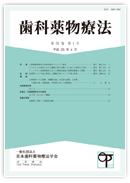All issues

Volume 33 (2014)
- Issue 3 Pages 115-
- Issue 2 Pages 91-
- Issue 1 Pages 1-
Volume 33, Issue 1
Displaying 1-5 of 5 articles from this issue
- |<
- <
- 1
- >
- >|
Original Articles
-
NORIO HORIE, TAKAHIDE NAGAO, SHUNSUKE HINO, TAKAO KATO, TAKAHIRO KANEK ...2014Volume 33Issue 1 Pages 1-9
Published: April 01, 2014
Released on J-STAGE: September 05, 2014
JOURNAL FREE ACCESSAlthough rikkosan is a Kampo medicine effective for orofacial pain, mechanism of action and pharmacokinetics of rikkosan is still unclear. Furthermore, the quantitative analysis of the analgesic effect of rikkosan has not been reported. To optimize the administration conditions, the analgesic effect of rikkosan was evaluated by pseudonocieceptive responses (Writhing syndrome and Tail pinch). Twenty minutes pre-treatment with rikkosan (100 or 200mg/kg) significantly reduced the acetic acid-induced stretch movements (Writhing syndrome) in mice, however, the analgesic effect was impaired at 400mg/kg. There were no significant differences in the analgesic effect between rikkosan (100 and 200mg/kg), acetaminophen (300mg/kg), aspirin (300mg/kg) and morphine (10mg/kg), and extension of pre-treatment period (40-90 min) potentiated the analgesic effect of 400mg/kg rikkosan. On the other hand, all analgesics, except morphine, failed to inhibit biting reflex induced by Tail pinch. These results suggest that more than 40 min prior administration of less than 200mg/kg rikkosan is required to obtain the maximum analgesic effect. Moreover, the different mechanism of action of rikkosan from morphine is also suggested.View full abstractDownload PDF (594K) -
YUKO F. IKEDA, MARIKO R. OKAMOTO, KEN YAMAMOTO, TAKAHIRO K. IMAMURA, S ...2014Volume 33Issue 1 Pages 10-17
Published: April 01, 2014
Released on J-STAGE: September 05, 2014
JOURNAL FREE ACCESSPurpose: The purpose of this study was to investigate sleep quality and its related factors in dry-mouth patients. Subjects and Methods: A cross-sectional study was conducted in 362 patients who visited the Dry Mouth Clinic at Tsurumi University Dental Hospital with the complaint of oral dryness. Sleep quality was assessed using the Japanese version of the Pittsburgh Sleep Quality Index (PSQI-J), and factors associated with the PSQI-J global score were analyzed by multiple regression. The dependent variable was the PSQI-J global score, while age, gender, resting saliva flow rate (RSFR), stimulated saliva flow rate (SSFR), VAS score of nocturnal dry mouth sensation, the presence or absence of snoring, grinding, clenching, and mouth breathing, and anxiety and depression score in the Hospital Anxiety Depression Scale (HADS) were used as the independent variables. Results: The mean PSQI-J global score was 7.9±3.9, and 232/362 (64.1%) cases were considered to be poor sleepers who showed a score of less than 5.5. The multiple regression analysis showed that anxiety (standardizing coefficient 0.330) and depression score (0.151) in HADS, nocturnal dry-mouth sensation (0.165), and age (0.209) were significantly associated with the PSQI-J global score. Conclusion: Anxiety, depression, and sleep-related xerostomia were found to be factors closely associated with the risk of disturbance of good sleep quality.View full abstractDownload PDF (357K) -
TAKAYUKI TSUYUKI, HIROSHI IWABUCHI, SHIGEYUKI OZAWA, KENJI SUZUKI, YOS ...2014Volume 33Issue 1 Pages 18-26
Published: April 01, 2014
Released on J-STAGE: September 05, 2014
JOURNAL FREE ACCESSWe examined whether decreased salivary secretion in patients with Sjögren's syndrome (SS) would be associated with their mental health. We also administered salivary secretion-promoting agents to patients with SS accompanied by decreased salivary secretion and examined whether increased salivary secretion improved their mental health. The subjects were 54 patients with SS who received cevimeline hydrochloride hydrate for 52 weeks. Mental health condition was evaluated on the basis of the General Health Questionnaire (GHQ) 30 score; a GHQ score of ≥7 was determined as neurosis. Subjective symptom scores and GHQ scores were measured before starting the medication and every 3 months subsequently. Of 54 patients, 36 (66.7%) were considered to have neurosis. No correlation was observed among GHQ30 scores, salivary secretion, and subjective symptom scores in patients with SS. However, among patients with neurosis, a significant correlation was observed between the improvement rate of GHQ30 scores before and after beginning the medication and the increase in salivary secretion in 7 patients who responded to cevimeline hydrochloride hydrate administration (R = 0.702, P = 0.036). These results indicated that a high proportion of patients with SS have neurosis, but it was not apparent whether decreased salivary secretion was a causative factor. However, the results suggested that it might be possible to improve mental health conditions when salivary secretion is sufficiently increased in patients with SS who also have neurosis.View full abstractDownload PDF (424K)
Case Report
-
MIHO KAMOI, MARIKO R. OKAMOTO, YUKO F. IKEDA, KEN YAMAMOTO, SHIGEO YAM ...2014Volume 33Issue 1 Pages 27-31
Published: April 01, 2014
Released on J-STAGE: September 05, 2014
JOURNAL FREE ACCESSA case of candidal cheilitis showing an apparent swelling of the lower lip of an 82-year-old woman is reported. The cheilitis was accompanied by erythematous candidiasis. Oral candidiasis is classified into three major variants based on clinical manifestation: pseudomembranous, erythematous (atrophic) and hyperplastic. In addition, there are several other lesions associated with Candida infection, such as denture-induced stomatitis, median rhomboid glossitis, and angular cheilitis. Candidal cheilitis is usually an erosive lesion of the middle lower lip; swelling of the lips is not the characteristic clinical finding of candidiasis. Thus, the finding itself was not sufficient to diagnose candidiasis clinically. A microscopic examination of a smear specimen stained with the fluorescence dye Fungiflora Y, which demonstrates hyphae of Candida, was useful for the diagnostic work-up and its differential diagnosis. A quick diagnosis using microscopic examination makes it easy to perform appropriate antifungal chemotherapy. Although swelling has not been considered a common sign in oral candidiasis, clinicians should remember that Candida infection is one of the causes of swelling of the lip.View full abstractDownload PDF (497K)
Study
-
[in Japanese]2014Volume 33Issue 1 Pages 32-44
Published: April 01, 2014
Released on J-STAGE: September 05, 2014
JOURNAL FREE ACCESSDownload PDF (505K)
- |<
- <
- 1
- >
- >|